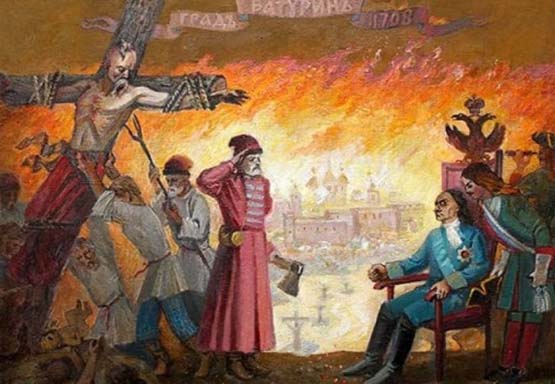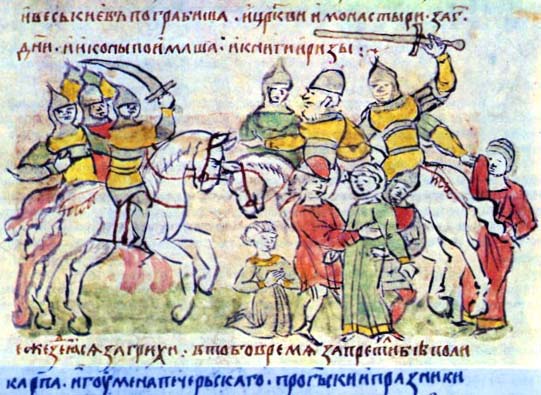The Pillaging of Kyiv by Andrey Bogolyubsky in 1169. The miniature of the Radzivill
Chronicle or Konigsberg Chronicle. Internet open sources.
More than three centuries, Ukraine was within the Russian Empire (later the empire changed its name into the Soviet Union). The Ukrainians were compelled to assimilate and take the traits of the social life unification. This built the grounds for the Russian authorities to manipulate with the idea of the unique character of the Russian- Ukrainian relations. They claimed as if the Ukrainians had always pursued the aim of establishing the state together with the Russians.
Actually, the relations between the Russians and the Ukrainians have been in the form of the constant wars lasting the several centuries. The origin of this confrontation dates back to the 12th century, the time when within the Ukrainian state of Rus, there appeared the germs of the states to be called Muscovy, Moscovia or Russia later. They were the Rostov Principality and the Suzdal Principality. Andrey Bogolyubsky, the Vladimir-Suzdal prince, made two depredation raids on Kyiv in 1169 and 1172. “With Andrey Bogolyubsky, the Great Russian entered the historical stage”, Russian historian V. Klyuchevsky wrote. Thus, the Russians were behaving as aggressors just right from the very beginning.
Later, the Ukrainians were fighting against the Muscovites within either the Lithuanian army or the Polish one. In particular, during the Muscovite-Lithuanian war (the Russo-Lithuanian War) in 1512-1522, the Ukrainians with prince Konstantyn Ostrozky in charge were actively fighting in the victorious battle of Orsza (Orsha) in 1514.
During the Russo-Polish war in 1605-1618, the Ukrainians participated in the battles within the Polish army, and it was not a single-time practice. At the end of the war, namely in 1618, the eighteen thousand Cossack army lead by Petro Konashevych-Sahaidachny managed to reach the territories near Moscow, seizing the Russian fortresses and towns.
After establishing the Ukrainian Cossack state of Hetmanate in 1648, the Ukrainians were opposing the Russian conquerors. In 1658, the Russians initiated the hybrid war against Ukraine with the purpose to support the conspiracy against Ivan Vyhovskyi. The most known battle of this war was the Battle of Konotop (1659), in which the Cossack army defeated the Russian one completely.
Later on, Russia started to apply a wide range of military, administrative and economic measures directed towards the destruction of the Ukrainian statehood. In 1674–1676, the Russian authorities acted through the Cossacks loyal to them. Such Cossack regiments were commanded by Ivan Samoilovych and twice attempted to seize the Cossack capital of Chyhyryn.
Hetman Petro Doroshenko with his Cossacks defended the capital. They had the military support from the Turkish army, but the sudden refusal of the latter to participate any longer had the adverse effect on the situation and the capital was occupied after the second siege. Petro Doroshenko eventually had to abdicate his mace (bulava) that meant the resigning act as bulava was the symbol of hetman power.
In 1708-1709, the Ukrainian army lead by hetman Ivan Mazepa and the Swedish allies stood against Peter I, the Russian tsar, who tried to eliminate the Ukrainian statehood. As the frightening measures, the tsar ordered to destroy the Ukrainian capital of Baturyn in 1708. The tragedy of this massacre was reported in details in the European newspapers, since it was extremely barbaric. Such cruelty of the Russians had never been seen before and was directed to the civilians and the city infrastructure as the reaction to the desire of the Ukrainians to live independently.

In 1711, hetman Pylyp Orlyk, the successors of Ivan Mazepa, tried to drive the Russians from the Right-Bank Ukraine and reached Kyivshchyna (Kyiv region), being supported by the Zaporozhian Cossacks with otaman Kostia Hordiienko in charge and by the Turk-Tartar army. However, they had to retreat after the Turks betrayed them and left.
The Ukrainian-Russian confrontation in the 20th century was no less cruel than the previous ones. After the decay of the Russian empire, the Bolsheviks took the power and attacked the Ukrainian National Republic in December 1917. When at the beginning of February 1918, the Russian troops entered Kyiv, they terrorised the local Ukrainian inhabitants. Alternatively, victorious at times and defeated at other times, the Ukrainian National Republic was fighting against the Russians until 1922, the year when the Ukrainian army was interned into Poland. Not only versus the Bolsheviks in 1918–1920, the Ukrainians had to counteract against the Russian voluntary army of the White Guards or the White Army (Belogvardejtsy), the anti-Bolshevik force. The Ukrainians did not manage to preserve their statehood since there was neither unity within the country, nor dependable allies out of it, but the mean Russian propaganda was acting effectively through the hybrid methods and taking the favour of the disputes among the Ukrainians.
Under the conditions of the statelessness, that was the middle of the 1940s and up to the end of the 1950s, the Ukrainians within the uprising army were fighting against the Soviet power. The resistance of the Ukrainians was so strong and the local population support was regular, that the Russian started to apply the traditional methods for them – hybrid war. The NKVD (the People's Commissariat for Internal Affairs or the Soviet security police) dressed in the form of the Ukrainian Insurgent Army (UPA) and committed terrible crimes against the locals. The Soviet authorities often announced the amnesty, but on revealing the UPA soldiers, imprisoned them all.
After proclaiming the Independence of Ukraine in 1991, the Russian authorities did not abandon the attempts to conquer Ukraine. At the beginning of the 1990s, the Russian Federation encouraged the separatist movements amongst the Autonomous Republic of Crimea. In 2003, it arranged the conflict concerning the Tuzla island. In March 2014 – annexed the Crimea and actually initiated the war, locally first at Donbas region and the full-scale intervention since 24.02.2022.
Eventually, it is more than 800 years of the Ukrainian-Russian confrontation, which became acute in the 17th century, after the Cossack state formation, and grew into the constant one in the 20th century. This confrontation is of the ontological character and it seems it will not subside until the Russian state is in the political map. They do not give us the other choice but “Carthago delenda est!”
Our advice to Read:
1. Брехуненко В.А. Війна за свідомість. Російські міфи про Україну та її минуле.‒ Київ, 2017.‒ 280 с.
2. Брехуненко В. Україна й українці. Ім'я як поле битви.– Київ, 2020.– 272 с.: іл., карти, фот.
3. Гаврилів І. Україна-Росія: протиборство европейської та евразійської цивілізацій.– Львів: Левада, 2018.– 107 с.: 3 л. карт.











